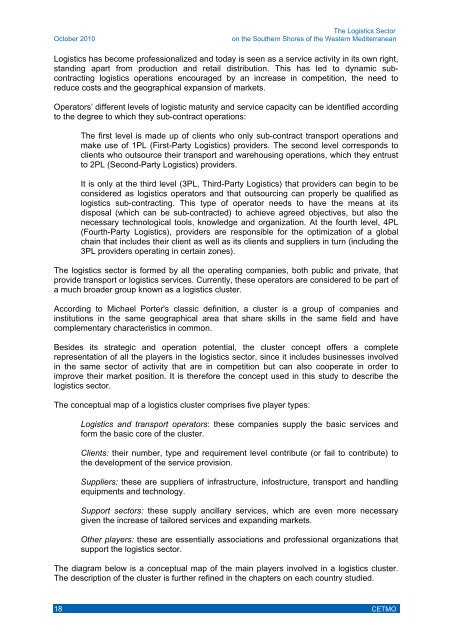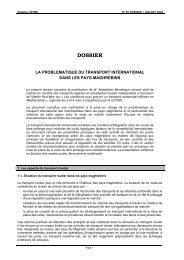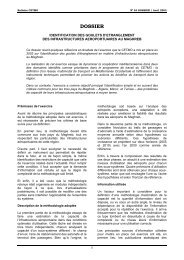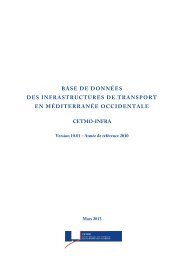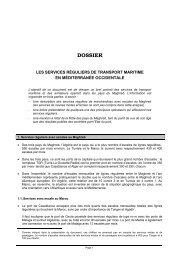The Logistics Sector on the Southern Shores of the Western ... - cetmo
The Logistics Sector on the Southern Shores of the Western ... - cetmo
The Logistics Sector on the Southern Shores of the Western ... - cetmo
- No tags were found...
Create successful ePaper yourself
Turn your PDF publications into a flip-book with our unique Google optimized e-Paper software.
October 2010<str<strong>on</strong>g>The</str<strong>on</strong>g> <str<strong>on</strong>g>Logistics</str<strong>on</strong>g> <str<strong>on</strong>g>Sector</str<strong>on</strong>g><strong>on</strong> <strong>the</strong> Sou<strong>the</strong>rn <strong>Shores</strong> <strong>of</strong> <strong>the</strong> <strong>Western</strong> Mediterranean<str<strong>on</strong>g>Logistics</str<strong>on</strong>g> has become pr<strong>of</strong>essi<strong>on</strong>alized and today is seen as a service activity in its own right,standing apart from producti<strong>on</strong> and retail distributi<strong>on</strong>. This has led to dynamic subc<strong>on</strong>tractinglogistics operati<strong>on</strong>s encouraged by an increase in competiti<strong>on</strong>, <strong>the</strong> need toreduce costs and <strong>the</strong> geographical expansi<strong>on</strong> <strong>of</strong> markets.Operators’ different levels <strong>of</strong> logistic maturity and service capacity can be identified accordingto <strong>the</strong> degree to which <strong>the</strong>y sub-c<strong>on</strong>tract operati<strong>on</strong>s:<str<strong>on</strong>g>The</str<strong>on</strong>g> first level is made up <strong>of</strong> clients who <strong>on</strong>ly sub-c<strong>on</strong>tract transport operati<strong>on</strong>s andmake use <strong>of</strong> 1PL (First-Party <str<strong>on</strong>g>Logistics</str<strong>on</strong>g>) providers. <str<strong>on</strong>g>The</str<strong>on</strong>g> sec<strong>on</strong>d level corresp<strong>on</strong>ds toclients who outsource <strong>the</strong>ir transport and warehousing operati<strong>on</strong>s, which <strong>the</strong>y entrustto 2PL (Sec<strong>on</strong>d-Party <str<strong>on</strong>g>Logistics</str<strong>on</strong>g>) providers.It is <strong>on</strong>ly at <strong>the</strong> third level (3PL, Third-Party <str<strong>on</strong>g>Logistics</str<strong>on</strong>g>) that providers can begin to bec<strong>on</strong>sidered as logistics operators and that outsourcing can properly be qualified aslogistics sub-c<strong>on</strong>tracting. This type <strong>of</strong> operator needs to have <strong>the</strong> means at itsdisposal (which can be sub-c<strong>on</strong>tracted) to achieve agreed objectives, but also <strong>the</strong>necessary technological tools, knowledge and organizati<strong>on</strong>. At <strong>the</strong> fourth level, 4PL(Fourth-Party <str<strong>on</strong>g>Logistics</str<strong>on</strong>g>), providers are resp<strong>on</strong>sible for <strong>the</strong> optimizati<strong>on</strong> <strong>of</strong> a globalchain that includes <strong>the</strong>ir client as well as its clients and suppliers in turn (including <strong>the</strong>3PL providers operating in certain z<strong>on</strong>es).<str<strong>on</strong>g>The</str<strong>on</strong>g> logistics sector is formed by all <strong>the</strong> operating companies, both public and private, thatprovide transport or logistics services. Currently, <strong>the</strong>se operators are c<strong>on</strong>sidered to be part <strong>of</strong>a much broader group known as a logistics cluster.According to Michael Porter's classic definiti<strong>on</strong>, a cluster is a group <strong>of</strong> companies andinstituti<strong>on</strong>s in <strong>the</strong> same geographical area that share skills in <strong>the</strong> same field and havecomplementary characteristics in comm<strong>on</strong>.Besides its strategic and operati<strong>on</strong> potential, <strong>the</strong> cluster c<strong>on</strong>cept <strong>of</strong>fers a completerepresentati<strong>on</strong> <strong>of</strong> all <strong>the</strong> players in <strong>the</strong> logistics sector, since it includes businesses involvedin <strong>the</strong> same sector <strong>of</strong> activity that are in competiti<strong>on</strong> but can also cooperate in order toimprove <strong>the</strong>ir market positi<strong>on</strong>. It is <strong>the</strong>refore <strong>the</strong> c<strong>on</strong>cept used in this study to describe <strong>the</strong>logistics sector.<str<strong>on</strong>g>The</str<strong>on</strong>g> c<strong>on</strong>ceptual map <strong>of</strong> a logistics cluster comprises five player types:<str<strong>on</strong>g>Logistics</str<strong>on</strong>g> and transport operators: <strong>the</strong>se companies supply <strong>the</strong> basic services andform <strong>the</strong> basic core <strong>of</strong> <strong>the</strong> cluster.Clients: <strong>the</strong>ir number, type and requirement level c<strong>on</strong>tribute (or fail to c<strong>on</strong>tribute) to<strong>the</strong> development <strong>of</strong> <strong>the</strong> service provisi<strong>on</strong>.Suppliers: <strong>the</strong>se are suppliers <strong>of</strong> infrastructure, infostructure, transport and handlingequipments and technology.Support sectors: <strong>the</strong>se supply ancillary services, which are even more necessarygiven <strong>the</strong> increase <strong>of</strong> tailored services and expanding markets.O<strong>the</strong>r players: <strong>the</strong>se are essentially associati<strong>on</strong>s and pr<strong>of</strong>essi<strong>on</strong>al organizati<strong>on</strong>s thatsupport <strong>the</strong> logistics sector.<str<strong>on</strong>g>The</str<strong>on</strong>g> diagram below is a c<strong>on</strong>ceptual map <strong>of</strong> <strong>the</strong> main players involved in a logistics cluster.<str<strong>on</strong>g>The</str<strong>on</strong>g> descripti<strong>on</strong> <strong>of</strong> <strong>the</strong> cluster is fur<strong>the</strong>r refined in <strong>the</strong> chapters <strong>on</strong> each country studied.18 CETMO


